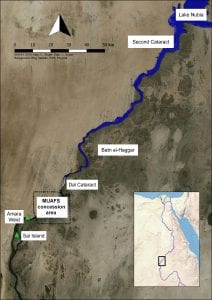DiverseNile
The multidisciplinary ERC Consolidator Grant project DiverseNile will explore a crucial part of northern Sudan as a case study to reconstruct Bronze Age biographies (c. 1650–1200 BCE) beyond the present categories ‘Egyptian’ and ‘Nubian’. The main hypothesis is that degrees of cultural diversity become archaeologically more visible in the peripheral zones of the central sites.
The area which will be explored is the research concession of the Munich University Attab to Ferka Survey Project (MUAFS). This stretch along the Nile including various islands between Attab and Ferka in northern Sudan is located next to a cataract region and the natural frontier of the rocky outcrop of the Batn el-Haggar. It is both a geological boundary zone as well as a frontier zone in terms of cultures being in the vicinity of main urban centres of the region, Sai Island and Amara West.
The well-established categorisation of archaeological sites will be challenged with our bottom-up approach focusing on individual sites and applying a new concept of studying intercultural encounters using the model of ‘contact spaces’, adapted for cultural borderscapes and expanded with a landscape biography approach. We will specify the question of cultural encounters by means of the distribution of the sites and their duration, settlement infrastructures, building techniques, productive activities and technologies, trade, diet, material culture, burial customs and religious practices as well as social structures. We will address aspects of acceptance, appropriation and ignorance/rejection of cultural symbols including not only Egyptian aspects but also phenomena relating to the most prominent indigenous groups of the region in the Middle Nile.
Our new approach to reconstruct the biography of a landscape considering humans, non-humans, technologies and environmental properties in a peripheral frontier region in northern Sudan has four main objectives:
→ Objective 1: to highlight the social practice in borderscapes by disentangling dwelling places from previous cultural categorisations, and by reconstructing the dynamics of an ancient ‘contact space’ showing acceptance, appropriation or ignorance of various cultural influences (Work package 1);
→ Objective 2: to illustrate the cultural diversity on the religious level by disentangling burial grounds from previous cultural categorisations, reconstructing dynamics of an ancient ‘contact space’, and showing acceptance, appropriation or ignorance of various cultural influences (Work package 2);
→ Objective 3: to reconstruct cultural encounters based on the material record by the detailed assessment of the most important productive activities, technologies and foodways (Work package 3), focusing on 1) the typology, technology, material, function and contents of pottery, 2) the typology, technology, material and function of tools (stone, bone and wood) and 3) the faunal, human and botanical remains introducing strontium and lead isotope analysis for questions of mobility;
→ Objective 4: to reconstruct the biography of a border landscape by investigating the geological and geomorphological features of the study area as a framework for the historical and cultural processes (Work package 4), thus creating a portrait of a social space (as evident from Work package 1–3) and its environmental framework that is comparable to other examples around the world.
To achieve these aims, the project comprises four work packages (WP 1–4), bringing together archaeologists with scientists from other disciplines (geology, soil science, chemistry, nuclear physics and physical anthropology), applying diverse methods (e.g. optical microscopy, strontium and lead isotope analysis, instrumental neutron activation analysis). Our reconstruction of living conditions of various cultural groups of Bronze Age Middle Nile will include the investigation of past environmental and climatic settings as well as a comparative approach with central sites of ‘Egyptian’ and ‘Nubian’ type (Sai Island, Amara West and Kerma).
We expect that the present comprehension of categorisations of ‘Nubian’ or ‘Egyptian’ sites will be significantly revised by this new method capitalising on the concept of the dynamics of cultural encounters. DiverseNile will thus add most important new insights to the growing debate of how to understand ‘Nubian’ and ‘Egyptian’ in antiquity.



